Is Everest Base Camp worth doing? Who should do it? What’s the reality of hiking to EBC in the Himalayas?
These questions were all on my mind as I planned my 2024 trip to Nepal, and ran around my brain while I flew out to Kathmandu and took a rather hair-raising 18-minute flight from Ramechhap to Lukla, the start of the Everest Base Camp trail.
I hadn’t found a raw, honest account of whether the Everest Base Camp trek is worth it online, so I endeavoured to create one as soon as I returned.
And this is it! My honest opinions on if the Everest Base Camp is worth it, who should do it and some important considerations to make before planning your trip.
Let’s get into it!
Is Everest Base Camp worth doing?

In my opinion, yes. While there were definitely parts of the EBC hike I didn’t enjoy (throwing up in a tea house toilet and questioning if I’d ever make it to the top of a very steep incline were amongst them!), I’m very, very glad I did it.
It’s been on my bucket list for a long time and there were parts that I absolutely adored!
However, I do think it’s important to carefully consider the realities (the good and the bad!) of the hike before setting out.
Reasons to hike to Everest Base Camp
So, why do people hike to Everest Base Camp?
Well, I have a few personal reasons, plus some were bounced around by my group as we trekked.
The scenery is like no other

As you’d expect from the world’s highest mountains, the Himalayan scenery is out of this world!
On the lower levels, you’ll follow the bright blue Dudh Koshi River snaking through the valleys, crossing suspension bridges adorned with prayer flags and stupas and temples paying homage to Nepal’s rich religion.
As you ascend, the trees are replaced by shrubs, and temples are few and far between. But you’ll start to see the soaring snow-capped mountains, which loom closer as you near base camp.
It’s among the most beautiful scenery I’ve ever seen in my life, and for this alone, Everest Base Camp was worth doing for me.
Wonderful Nepalese culture is amplified in the mountains

Nepal has a beautiful culture, with vibrant festivals, fascinating religions and wonderful people.
This is only amplified in the mountains, where tea houses throw open their doors to welcome tired trekkers and monks at temples bless tourists and wish them a safe journey.
One of the highlights of base camp, for me, was getting to chat with my guide, Ram.
He told me lots of stories about growing up in the Himalayan mountains (he’s not from the Everest region, but another mountainous area of Nepal) and I gained a much deeper understanding of Nepali culture than I would have just exploring the country independently.
It’s a physical and mental challenge

While none of the distances are particularly long when you’re hiking to Everest Base Camp, the uphills are challenging, as is hiking every single day for 11 days in a row at altitude. (Check out a typical Everest Base Camp itinerary here.)
The most difficult part, for me, was on night four, when I felt very unwell and was sick at the tea house. I felt better the next morning (if I was still being sick, I would have had to take another day to try and acclimatize, as we weren’t sure if I had altitude sickness for food-related issues) so I carried on hiking, but my body was weak and it was difficult.
While this was a challenge, I’m proud of myself for overcoming it – and I’m proud of my body for getting myself to 5,364 metres and back down!
So, while it’s a challenge, the sense of achievement at the end is great.
It’s an opportunity to learn about something many of us know nothing about

Before planning my Everest Base Camp hike, I knew nothing about mountaineering. I’d read Krakeur’s Into Thin Air a long time ago, but other than that, had no idea about what goes into summiting Mount Everest.
After learning about it some more, I’m very happy to just know about it and not attempt it myself – but I never would have learned about it in such detail if I hadn’t hiked to Everest Base Camp.
Here are a few facts I picked up:
- Summiteers stay at Everest Base Camp for around two months before their summit attempt.
- In this time, they make four acclimatisation hikes. They hike to Camp 1 and return to base camp, then do the same up to camp 2 and camp 3. This helps their bodies adjust to the altitude and hopefully be able to summit successfully.
- Every time they go up the mountain, they must cross the Khumbu Icefall. This is a huge glacial area that’s constantly moving. Each year, heroic Sherpas set up ladders to enable climbers to climb over and up the ice – which look hair raising themselves – and there’s also a risk of seracs (huge blocks of ice that can be the size of large buildings) falling at any moment.
- The area above 8,000 metres is known as the “death zone”. Above this altitude, your body literally begins to die, which is why summit attempts must be made as quickly as possible.
- There is a big issue with inexperienced climbers trying to climb to the top of Everest, which can risk their Sherpa guides’ and porters’ lives. While many Sherpas want to climb Everest for their own personal reasons and take the jobs because of this, they deserve to be paid much more and they shouldn’t have to take unfair risks. This is a huge issue with summiting Everest and is something that needs to be addressed.
I will never summit Everest – I feel uncomfortable about how it impacts Sherpas (as I don’t think I’d ever qualify as an “experienced climber”), I’m far too clumsy, I’m not dedicated to that level and I don’t fancy doing something that has a 3% fatality rate, but I did find it very interesting to learn about while I was in the region.
It’s a huge bucket list tick

Write a list of the biggest bucket list activities in the world, and I bet hiking Everest Base Camp will be on there.
It’s one of those places where you can experience the extremes of life, see scenery that’s (probably) completely different to home and witness the most remarkable people and society that survives up to five kilometres above sea level.
For me, it was always top of my bucket list ever since we learned about Mount Everest at school.
Nothing comes close to seeing the world’s highest mountain
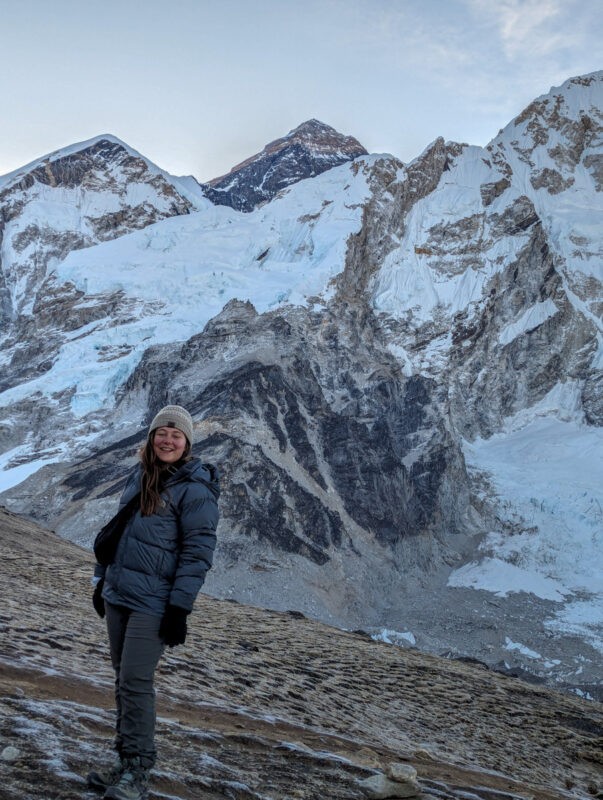
And, while I’ve been to 73 countries and counting, nothing is like hanging out with the world’s highest mountain.
(Fun fact: Everest isn’t actually the tallest mountain in the world – that award goes to Mauna Kea, who is mostly underneath the sea. But it is the highest point on Planet Earth.).
The first time we saw Everest on our route, I was spellbound. I spent a few minutes just staring at it, thinking “this is one of the extremes of the earth, and I’m looking at it with my own eyes”.
Discounting altitude, the hike isn’t too difficult
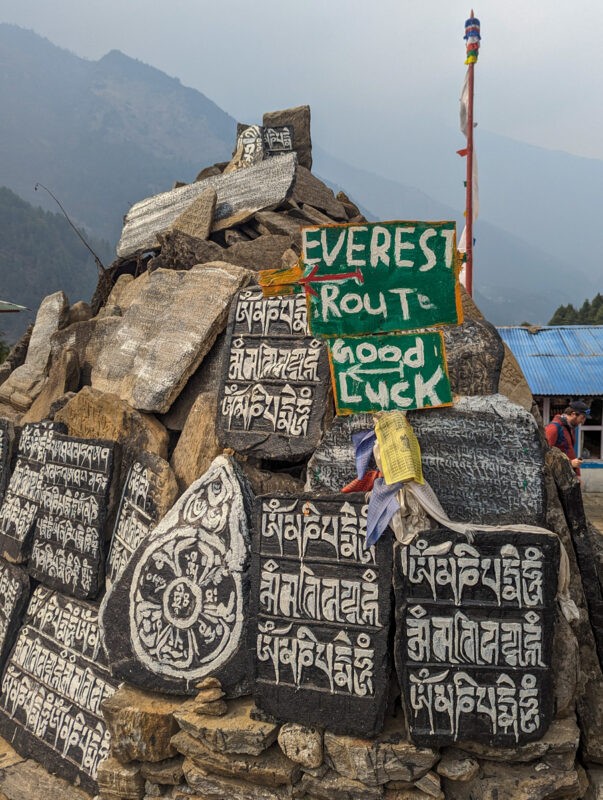
Climbing to Everest Base Camp is difficult in its own ways.
The altitude should not be underestimated, and in all honesty, I’d highly recommend trekkers go hiking at over 2,500 meters altitude if possible before they tackle the trek to base camp.
But the terrain isn’t too challenging.
There are some steep and difficult uphills – the hill to Namche Bazar and the switchbacks to Tengboche Monastery come to mind – but generally, it’s “Nepali flat” – a bit of up, a bit of down and some flat.
My legs barely even ached after each day!
However, like I said, each hike was made more challenging by the altitude.
Which is my main consideration for hiking EBC!
Considerations for hiking Everest Base Camp
Here are some things that you should bear in mind before planning to hike to Everest Base Camp.
The altitude can be tough
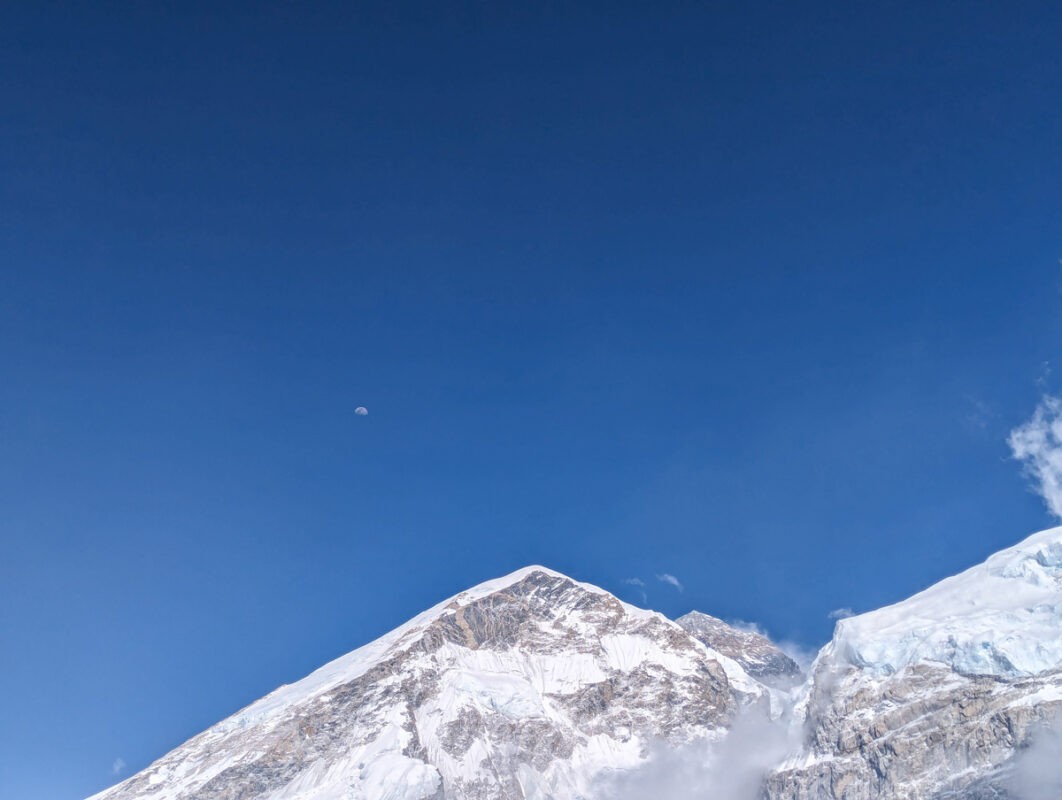
First up, the altitude!
This is what made the trek challenging for us (and is the same for most people). It’s the biggest safety issue when hiking to Everest Base Camp.
At Everest Base Camp, the air only has 50% of the oxygen of the air at sea level. This makes it harder to get the oxygen your body needs – you’ll hike slower, and take more breaks (which is normal and totally fine!).
You also may experience some altitude sickness. Common symptoms of altitude sickness are headaches, nausea, vomiting and dizziness.
I may have had mild altitude sickness one day, although I did feel a lot better the next morning (after taking Diamox and resting) so was ok to continue.
AMS (Acute Mountain Sickness) is a more extreme version of altitude sickness and is when it needs to be taken seriously. Severe AMS can be life-threatening. One of our group developed more serious AMS – his blood oxygen was 47% – and he had to be heli-evacuated (he was ok once he returned to lower altitude).
While we were in Dingboche, a trekker in the village tragically died due to altitude sickness.
It seemed that he didn’t acknowledge his symptoms in the early stages and then lost his group for a long time, and by the time they found him again, he was throwing up blood and hallucinating. This is rare, but it can happen.
However, provided you know the symptoms of early AMS and act accordingly (and have comprehensive travel insurance that covers helicopter evacuation!) this won’t happen to you.
Altitude sickness typically improves as soon as you get to lower heights.
Accommodation is basic
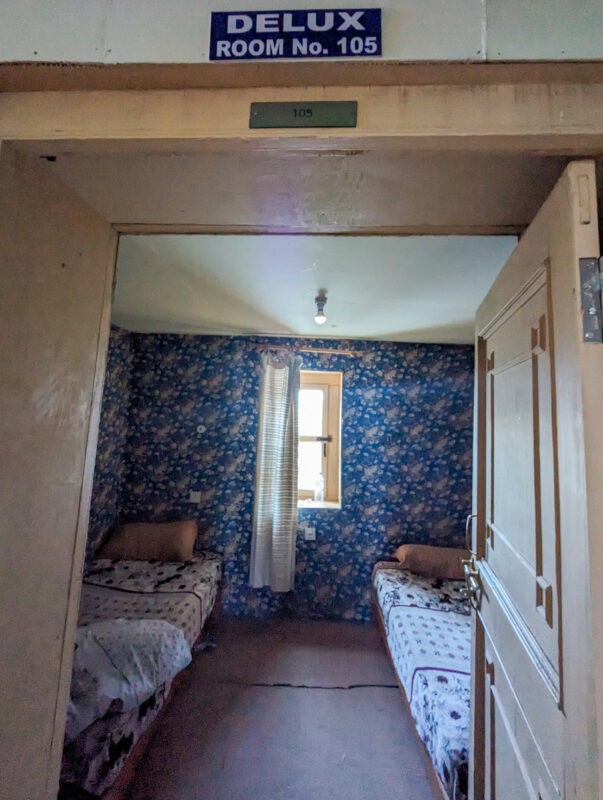
I’m sure nobody expects the Ritz when hiking to Everest Base Camp, and I was fairly happy with our rooms in most of the tea houses.
However, it’s important to stress that it’s basic. There’s minimal electricity past Namche Bazar (where you stay on nights two and three) – you can charge devices, but you’ll need to pay to do so.
There’s no heating in any of the rooms, so make sure you have a heavy-duty sleeping bag!
Bedlinen is provided, but I don’t think it’s usually washed after every use, so you’ll definitely want a sleeping bag and sleeping bag liner.
There were Western toilets in all the tea houses we stayed in, but they were shared in all but three teahouses. Some rooms higher up don’t have lights, so take a head torch to find the loo in the night!
Here’s a TikTok video I made about our tea house in Namche Bazar:
@clairesfootsteps Where do you sleep on the Everest Base Camp trek? If you're wondering about Everest Base Camp accomodation, the tea houses on the Everest Base Camp hike or general local guesthouses in Nepal, I go inside Hotel 8848 in Namche Bazar and show you what to expect from the bedrooms, bathrooms, showers and restaurant! #everestbasecamptrekking #nepal #nepaltrekking #ebc ♬ original sound – Claire: travel blogger 🌏
Generally, I was comfortable in everywhere we stayed apart from Mother Earth teahouse in Loboche, which didn’t have functional lights in the bedrooms, was very dirty and mouldy and smelt of animals (it was right next to stables).
I was happy to give them the benefit of the doubt as we were at 4,900 metres altitude, but Buddha Lodge in Gorak Shep, at about 5,200 meters altitude, was 10x nicer!
Food is repetitive
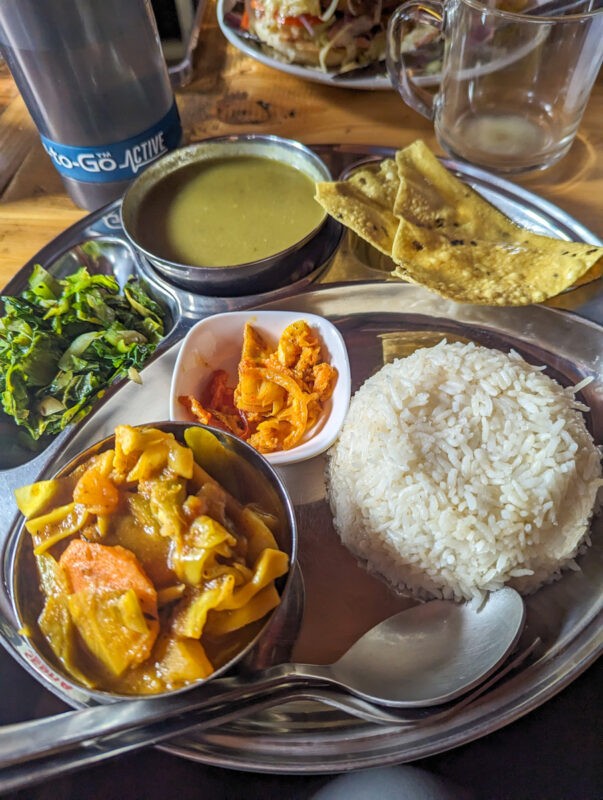
Just as accommodation is basic, food can be quite repetitive!
You’ll eat at the teahouse you stay every night and teahouses typically have the same menu. You’ll notice dishes like dal baht, fried noodles and potatoes at virtually every tea house.
After I was sick, I struggled a lot with the food.
I was worried something would make me ill again and could never work out what I wanted from the menu that would be the least risky.
Ramen was always a safe option (it was literally packet noodles and broth), I had a tasty hash brown at Gorak Shep and the veggie burger at Hotel 8848 in Namche Bazar was exemplary.
I’d recommend making sure you pack loads of snacks – preferably items that you know you like and will want to eat like familiar crisps and chocolate – to keep you going!
Minor illnesses are common
While only one of us had AMS, minor illnesses – related to altitude, sanitation, cold air and exertion – are common.
I had all of the following at some point in the trek!
- headaches (pretty much every day over 4,000 metres)
- diarrhoea
- cough
- sore throat
- cold symptoms
- nosebleeds
All of these are to be expected on the base camp trek – we all basically had a complete mobile pharmacy filled of drugs to tackle them – but they did still add to the challenge of the hike!
Most of these symptoms abated when I returned to lower altitudes.
Who should do the Everest Base Camp hike?
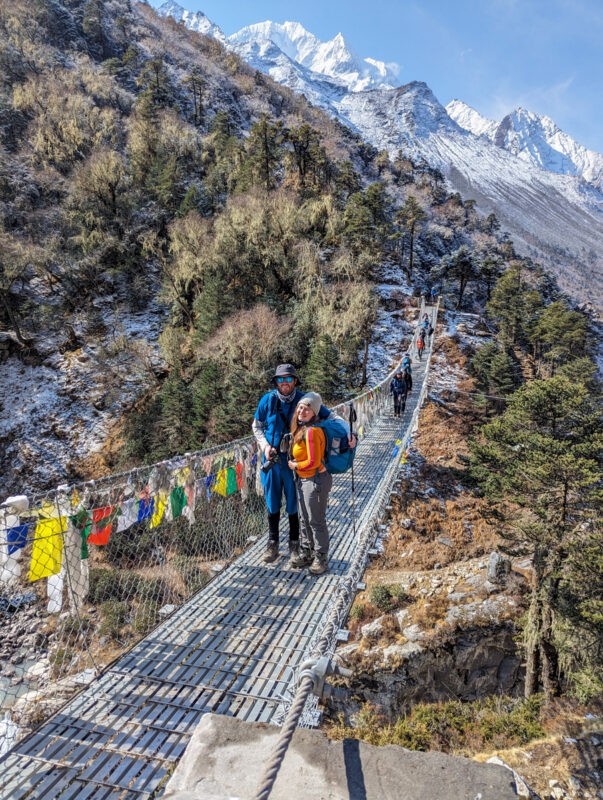
There’s no age limit on hiking to Everest Base Camp – anyone with an adventurous spirit and who is physically capable would love the trek! Our group was age 26 – 65.
However, I’d definitely recommend ensuring you have a good fitness level before heading out.
Young kids do hike to Everest Base Camp (I believe the youngest hiker there was two years old), but I did see a few kids who really weren’t enjoying themselves.
I’d recommend carefully thinking about taking your kids on the hike because it can be intense even for adults who choose to be there (and while I adore hiking now, I know when I was young it was tough for my parents to even get me to go on a two-mile walk!).
So, is Everest Base Camp worth it?
If you love travel and hiking and are keen to see the world’s highest mountains and learn a bit more about mountaineering and don’t mind going without creature comforts for 10 days or so, then yes Everest Base Camp is worth it.
It shouldn’t be romanticised – parts are mentally and physically challenging – but I’m still so happy that I did the hike!
I’ve been posting daily content on Instagram and TikTok, and will be sharing long-form videos on YouTube – so do follow me on those platforms for more!
